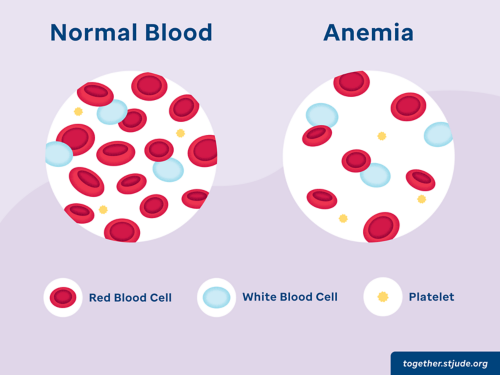Menu
Close
Back
Welcome to
Together is a new resource for anyone affected by pediatric cancer - patients and their parents, family members, and friends.
Learn MoreAnemia occurs when your body has fewer healthy red blood cells than normal. Red blood cells carry oxygen to your organs.

Anemia occurs when the body has fewer red blood cells than normal.
Iron-deficiency anemia happens when your body has low levels of a nutrient called iron. The body uses iron to make hemoglobin. Hemoglobin is what carries oxygen to body organs.
The main cause of iron-deficiency anemia is not getting enough iron from the foods you eat.
Other causes can include bleeding or having an illness that makes it hard for your body to absorb iron.
Signs and symptoms of iron-deficiency anemia include:
Another sign of iron deficiency anemia is called pica. Pica is eating things that are not food. These can include ice, chalk, dirt, clay, starch, tissue paper, and even house materials such as carpet and drywall. You should not let your child eat anything that is not food. Tell your doctor or nurse if you think your child has pica.
Diagnosis may be made by conducting a physical exam and taking a medical history. To be sure the diagnosis is correct, blood tests will be done. One of the blood tests may be a complete blood count (CBC). This will check the number of red blood cells in your blood (cell count), the amount of hemoglobin in your blood, the amount of space the red blood cells ls take up in the blood, and the average size of the red blood cells (Mean corpuscular volume or MCV).
Treatment depends on what is causing your child’s anemia and how seriously it affects them.
Treatment may include:
Common symptoms include feeling tired, dizzy, and weak. The care team may suggest periods of rest and may talk to you about ways to prevent falls. These methods include:
Your child may get iron medicine to take by mouth, such as a pill or liquid. Here are some tips to make the iron work well and prevent side effects:
Taking iron by mouth can cause your child to have darker bowel movements. Your child might also have constipation. This means bowel movements are harder and more difficult. You can give your child medicine to keep bowel movements normal and soft. Talk to your doctor or nurse.
—
Reviewed: September 2022